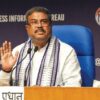Why children must be encouraged to play
The Olympic games being staged in Paris have evidently fascinated middle class India, if not the remainder of the population. Daily television viewership in India of the games staged between July 26-August 11 has reportedly ranged between 100 and 120 million, with the nation cheering the modest performance of our 117 track and field athletes. Even if India doesn’t perform well in international sports and games arenas, there’s little doubt that this country provides perhaps the largest number of sports spectators worldwide.
For India’s establishment and educators in particular, the Paris Olympics offers several takeaways. For one, the aesthetic beauty and efficient administration of the host city which enabled the clinical efficiency with which the games were organised. It’s impossible to believe that any of India’s ill-administered metropolitan cities can host Olympic games in the foreseeable future. Yet this is a good time to start working towards that objective.
The seeds of orderly civic governance have already been planted in the Constitution by the 73rd and 74th Amendments to the Constitution (1992) which mandate de-centralisation of governance and administration to the ward level. As often argued on this page, if civic wards managed by elected property owners are empowered to levy and collect property taxes and administer themselves, reporting to empowered municipal corporations headed by directly elected mayors, urban India would experience a dramatic transformation for the better.
The second takeaway is that we have to devise ways and means for India with its population of 1.4 billion to emerge as a respectable sports and games nation. It’s embarrassing that small countries with populations of 1 million and thereabouts bagged gold medals which at time of writing, India hasn’t won even one. According to a recent Unesco report titled Global State of Play, two-thirds of secondary and over half of primary students worldwide don’t receive required minimum weekly physical education, and two-third of countries spend less than 2 percent of their education budgets on physical education. In contemporary India, the condition is worse with most children denied even unstructured play opportunity. From youngest age, they are burdened with academic load and tuition.
The plain truth is that the prevalent model of selecting and training middle class children for international sporting excellence is flawed. The US, Australia and China examples are proof that world champions emerge when the pool of children playing sports and games is of oceanic size and every public primary and secondary school offers sports grounds and facilities and integrates play into the curriculum. This requires several multiples of the annual outlays that the Central and state governments allocate for education. That’s not impossible as our Special Report in this issue illustrates.
















Add comment